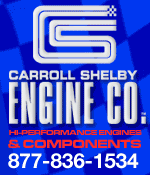 
 Main Menu
Main Menu
|
 Nevada Classics
Nevada Classics
|
 Advertise at CC
Advertise at CC
|
 January 2025
January 2025
|
| S |
M |
T |
W |
T |
F |
S |
| |
|
|
1 |
2 |
3 |
4 |
| 5 |
6 |
7 |
8 |
9 |
10 |
11 |
| 12 |
13 |
14 |
15 |
16 |
17 |
18 |
| 19 |
20 |
21 |
22 |
23 |
24 |
25 |
| 26 |
27 |
28 |
29 |
30 |
31 |
|
|
 CC Advertisers
CC Advertisers
|
|

10-03-2002, 05:44 AM
|
 |
CC Member

|
|
|
Join Date: Nov 1999
Location: Brisbane, Australia,
Q
Cobra Make, Engine: Contemporary CCX3117 427FE
Posts: 4,381
|
|

 Not Ranked
Not Ranked
For what it's worth, Motec (Fuel Injection Company) tech guys will ALWAYS recommend monitoring air fuel ratio over EGT. From what they say, O2 (lambda) sensors are more accurate, more reliable, faster acting and tell a more complete story. In the context of my supercharged motor, they mentioned that if a tune-up was a fair way off base, the EGT could read warm, hot, hotter, REALLY hot, then cooler -- all while the air fuel ratio is leaning out more and more. In this case, the EGT would be giving "false" readings, ones that a corresponding change in tune-up that will make head gaskets most unhappy.... 
__________________
Craig
|
-
Advertising


10-03-2002, 06:44 AM
|
|
CC Member

|
|
|
Join Date: Oct 2000
Location: Crystal Lake,
IL
Cobra Make, Engine: Everett-Morrison, 434 cid
Posts: 977
|
|

 Not Ranked
Not Ranked
Also for what it is worth, I agree with the Motec guys. Properly tuned, an engine will be slightly rich. As you lean it out and approach a stoichiometric mixture a.k.a. “lean best power” temps climb, once leaner than “lean best power” temps fall off. You never want to tune for “lean best power” because in that state of tune pistons are ready to melt, oil will break down, cylinder walls scuff, and heads can crack.
Scott |

10-03-2002, 08:56 AM
|
 |
CC Member

|
|
|
Join Date: May 2000
Location: Vacaville, CA, USA,
Posts: 149
|
|

 Not Ranked
Not Ranked
Scottj - thanks for correcting me on that.
750HP - I agree that that many experts think that A/F is a better indicator than EGT, but my experience has shown few dynos (at least up this way) that have A/F over EGT. I guess you take what you can. I attached a picture of my engine on the dyno. The lines you see hanging down to the individual exhaust tubes are the EGT lines. Luke, see the drum to the far right, in line with the driveline? Thats where the water goes in to apply resistance to the engine.
Brad
Last edited by Brad Pfeifer; 10-03-2002 at 09:02 AM..
|

10-03-2002, 09:05 AM
|
 |
CC Member

|
|
|
Join Date: Mar 2002
Location: so cal,
Cal
Cobra Make, Engine: I used to fix them for a living
Posts: 2,563
|
|

 Not Ranked
Not Ranked
The couple of dyno operators I know all rely on EGT readings on their dynos. That measure's the engine's reaction to applied load in the metric that matters most. I don't care how great my A:F ratio is if the exhaust temps are 1300 degrees. If you want to put EGT probes on your motor, an industry leader is: Exhaust Gas Technologies in anaheim CA. They sell them to Kenny Bernstein and other racers you have heard of, but also snowmobiles.
Watts to horsepower: 746 watts is one HP, which is something like 33,000 ft/lbs/hr.
__________________
In a fit of 16 year old genius, I looked down through the carb while cranking it to see if fuel was flowing, and it was. Flowing straight up in a vapor cloud, around my head, on fire.
|

10-03-2002, 09:32 AM
|
|
CC Member

|
|
|
Join Date: Oct 2000
Location: Crystal Lake,
IL
Cobra Make, Engine: Everett-Morrison, 434 cid
Posts: 977
|
|

 Not Ranked
Not Ranked
You might want to care if you have high EGT and good A/F ratio, it's telling you one or more of a number of things that can affect EGT is affecting it.
Brad- No thanks necessary, free advise is usually worth what you pay for it (forgot who said that). Research before believing, I or anyone here might not have a clue.
Scott
Last edited by scottj; 10-03-2002 at 09:54 AM..
|

10-04-2002, 12:03 AM
|
 |
CC Member

|
|
|
Join Date: Nov 1999
Location: Brisbane, Australia,
Q
Cobra Make, Engine: Contemporary CCX3117 427FE
Posts: 4,381
|
|

 Not Ranked
Not Ranked
So, if you have perfect air fuel ratios and the ignition timing is within a couple of degrees of an established baseline, what could make the EGTs become dangerously high?
|

10-04-2002, 06:59 AM
|
|
CC Member

|
|
|
Join Date: Oct 2000
Location: Crystal Lake,
IL
Cobra Make, Engine: Everett-Morrison, 434 cid
Posts: 977
|
|

 Not Ranked
Not Ranked
Exhaust timing that starts too early, header design, combustion chamber design. Also what EGT temp is the goal? Because of differences in chamber efficiency, old small block chevy race engines would run 1450 EGT while BB chevys would run 1650 EGT when tuned correctly. 9:1 race engines run such high EGT only a stainless header will last on one.
These examples are really development issues more than they are tuning issues, but development is what EGT and the dyno is intended for anyway, to tune the fuel curve on the dyno you must look at the A/F ratio.
Scott
|

10-06-2002, 09:17 AM
|
|
CC Member

|
|
|
Join Date: Mar 2001
Location: Indianapolis, Indiana, U.S.A.,
IN
Cobra Make, Engine: Home built, supercharged 544cu/in automatic
Posts: 924
|
|

 Not Ranked
Not Ranked

Bare with me a bit as its sunday morning and I just got up. I have been playing with dynos for years and I think some of the issues brought out in the above posts about dynos show there is a lot of folklore about these machines.
First off, the two most common is types of dynos are as listed above, a chassis dyno and a water brake engine stand type of dyno. There is a third type, a engine stand type that uses a type of torque converter setup.
Next, in spite of what you have been told none of them are accurate. Period! By that I mean no two dynos are exactly the same. I've never seen any dyno that could give you exactly the same numbers even on identical pulldown setups, on the same dyno, let alone the same numbers from a seperate dyno. So where does this leave you if the numbers you geting are only as good as the last pulldown you referance against? WELLLLLL that depends,,,,,,,,on the type of dyno you are using and what you are trying to do.
Engine stand type dynos are good for tuning engines and/or changing setups as eluted to above on the engines only. This is the hot setup for engine developement work, or if you just want a quick break in on a engine with some relative numbers. But I can't stress this enough,,,,,,, don't stay there long, as these types of pulldowns do not reflect real world engine uses. And these pulldowns are VERY hard on new engines. In fact I know one engine builder guy that will not warranty his engines if they are broke in on a dyno first! This type of dyno is the most usefull one for finding extreme problems or tuning problems because they don't mask problems with other factors associated in a car.
The second type of dyno is a chassis dyno or as most commonly called, a rear wheel dyno. It's the least accurate type of dyno but is a real world type of dyno because you test your engine in the car it's intended for. Some things to remember here are rear wheel dynos need to be rated at about twice the horsepower you are shooting for, to be anything like accurate. For example my engine puts out about 700 horsepower and in Indy I only know of one R.W. dyno that is rated to 1500 horsepower. If you don't care about accuracy of numbers, and this is where I am, then you can use underpower rated R.W. dynos quite effectively to tune a engine/car. That brings me to another point. This type of dyno can be used to measure power gains made by chassis tuning of your car. So if you install low friction brakes or a different rear end, or whatever, this is the guy that will measure gains made in this department. To me, this factor alone makes it the winner of the dyno wars.
About exaust gas temp. probes (EGT) vs. oxygen (O2) probes. Depends on the fuel you are using. If you are using any fuel that has oxygen in the formula such as alcohol or nitromethane then a O2 probe will read lean even when you are running rich. Thats why the top fuel guys use temp sensors and not O2 sensors. A temp. sensor is slow to respond though, unlike a O2 sensor and those same top fuel guys use temp sensors for telemetry data only, never for tuning/control on the fly.
Getting back to the real world and gas use now. I found that EGT probe readouts and power numbers are allmost identical to O2 probe readouts and power numbers on the same engines when using gas. The only differences are at the extreme edges of the bell curves and weird things happen there anyhow. For the example above of a EGT setup showing rich but actually running lean your engine would lean surge or backfire or something. Point is, on the extremes other things usially happen that tells you something is wrong. Its not brain surgury here guys. Where the techlology is right now though, O2 sensors are the only way to fly when using gas and tuning, esp. when using O2 sensors for tuning on the fly.
One other thing, If ypu are using O2 sensors to tune your engine on dynos make sure that the fuel/gas you are using to tune with does not have alcohol in it. It will skew your tuning results. It most likely will be O.K. to use acohol added fuels on the street after you set your engine up though. But boy, do I hate alcohol for a engines fuel, and for a bunch of reasons.
cobrashock
__________________
Ron Shockley
Last edited by cobrashoch; 10-06-2002 at 08:37 PM..
|

10-08-2002, 08:36 AM
|
 |
CC Member

|
|
|
Join Date: Mar 2002
Location: so cal,
Cal
Cobra Make, Engine: I used to fix them for a living
Posts: 2,563
|
|

 Not Ranked
Not Ranked
What about O2 sensors and leaded gas? I heard rumors that they don't play well together.
__________________
In a fit of 16 year old genius, I looked down through the carb while cranking it to see if fuel was flowing, and it was. Flowing straight up in a vapor cloud, around my head, on fire.
|

10-08-2002, 06:10 PM
|
|
CC Member

|
|
|
Join Date: Mar 2001
Location: Indianapolis, Indiana, U.S.A.,
IN
Cobra Make, Engine: Home built, supercharged 544cu/in automatic
Posts: 924
|
|

 Not Ranked
Not Ranked
Mr. Fixit - Don't know about leaded gas. Everyone I know switched over to unleaded about 1980. Even when buying racing fuel. Might be something to that though as some O2 sensors have platinum tips.
cobrashock
__________________
Ron Shockley
|

10-08-2002, 11:56 PM
|
 |
CC Member

|
|
|
Join Date: Nov 1999
Location: Brisbane, Australia,
Q
Cobra Make, Engine: Contemporary CCX3117 427FE
Posts: 4,381
|
|

 Not Ranked
Not Ranked
Mr Fixit - The Bosch LSU wideband O2 sensors are rated for only 50hrs use with leaded gas. Some of the Mustang racers heat the sensors with an Oxy torch, and this APPARENTLY brings them back to new again.
__________________
Craig
|

10-21-2002, 08:55 PM
|
|
CC Member

|
|
|
Join Date: Oct 2001
Location: Texas way out East,
Posts: 74
|
|

 Not Ranked
Not Ranked
see below
__________________
Well officer.. It was like this.
Last edited by mkcobra; 10-21-2002 at 09:07 PM..
|

10-21-2002, 08:58 PM
|
|
CC Member

|
|
|
Join Date: Oct 2001
Location: Texas way out East,
Posts: 74
|
|

 Not Ranked
Not Ranked

mr fixit,
i would whole heartedly disagree,
Nascar uses chassis dynos regularly , Dynojet is the offical Nascar dyno. they have units that will go to 1200hp , i know i have one. as for load testing they even have setup that will apply differential load so you can check for load related problems, yes the wheels have to have traction but remember you are not starting from a dead stop. this is done from what is called a roll on traction is less of a problem since your car is in 4 th gear or which gear gives your axle 1:1 ratio. we have had 700hp drag cars and no tire slipping. this is even with shooting nitrous in the middle of the run. you should check into the chassis setup first i think you will see it is used more than you think. as for tuning either can tune you motor. but if its installed why do you need to pull it out and make adjustments, second you can use the exact exhaust setup for better tuning not just headers attached to pipes. You can quickly make changes in the car and see results even after you did your engine dyno work. engine builders like engine dynos simple tool for their requirements. they dont care what car it goes into or what tranny it bolts to. every car tuner uses chassis dynos they dont what to pull the engine everytime they need to modify a car and still can prove gains or loss. not a flame war but over the last 4 years we have modified and tuned cars that no one would ever consider pulling the motor out to do. prime example when you supercharge an new vette (LS1) it has to be tuned under load for Fuel recalibration and timing . who would pull the motor after they just installed the supercharger . it bolts to the car not free standing. make some adjustments and then drive it home. went from 422 rear wheel HP to 472 Hp with a simple test run and LS1 edit software. just letting you know its not hype and a piece of paper. looking forward to commentary.
__________________
Well officer.. It was like this.
|
 Posting Rules
Posting Rules
|
You may not post new threads
You may not post replies
You may not post attachments
You may not edit your posts
HTML code is On
|
|
|
All times are GMT -7. The time now is 08:53 PM.
|

















 Linear Mode
Linear Mode



